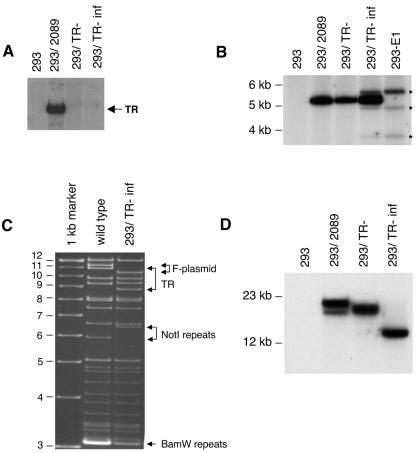FIG. 4.
293/TR infected cells carry the mutant TR− genome. (A and B) Southern blot analysis of 293/TR− cells, 293/2089 cells, and 293/TR-inf cells obtained by infection of 293-E1 cells with TR− supernatants. (A) BamHI-digested genomic DNA was submitted to Southern blot analysis using the EBV terminal repeat fragment as a probe. No TRs could be detected in both the 293/TR− and 293/TR-inf cell lines. (B) BamHI-digested genomic DNAs were hybridized with an EBNA1-specific probe (BamHI K fragment). This experiment confirmed that the 293/TR-inf cells carry an integrated EBNA1 plasmid (stars) and do not result from a contamination with cells from the 293/TR− producer cell line. (C) Restriction fragment analysis of viral plasmid DNA isolated from 293/TR-inf cells. Plasmid wild-type EBV DNA was used as a reference. The overall structure of the TR− genome present in 293/TR-inf cells is preserved and identical to that of wild-type recombinant EBV genome except for three restriction fragments that differ between both plasmids. The BamHI 10.7-kb fragment carrying the TRs in wild-type EBV has been exchanged for an 8.7-kb fragment in the mutant virus. In addition, the number of BamHI W and NotI repeats appears to differ between both viruses with wild-type EBV carrying a lower number of NotI repeats but a higher number of BamHI W repeats. Finally, a 700-bp deletion within the F plasmid that explains the shift from an 11.2-kb BamHI fragment to a 10.5-kb BamHI fragment could be identified. (D) Analysis of the BamHI W repeats in 293/TR− cells, 293/2089 cells, and 293/TR-inf cells using Southern blot analysis. Genomic DNA was cleaved with SpeI and PmeI, and the blot was hybridized with the BamHI W fragment as a probe. This assay shows that 293/TR-inf cells contain a virus with a lower number of BamHI W repeats than the helper virus present in 293/TR− cells. These results confirm the data obtained by restriction analysis of the EBV wild-type and TR mutant genomes.

